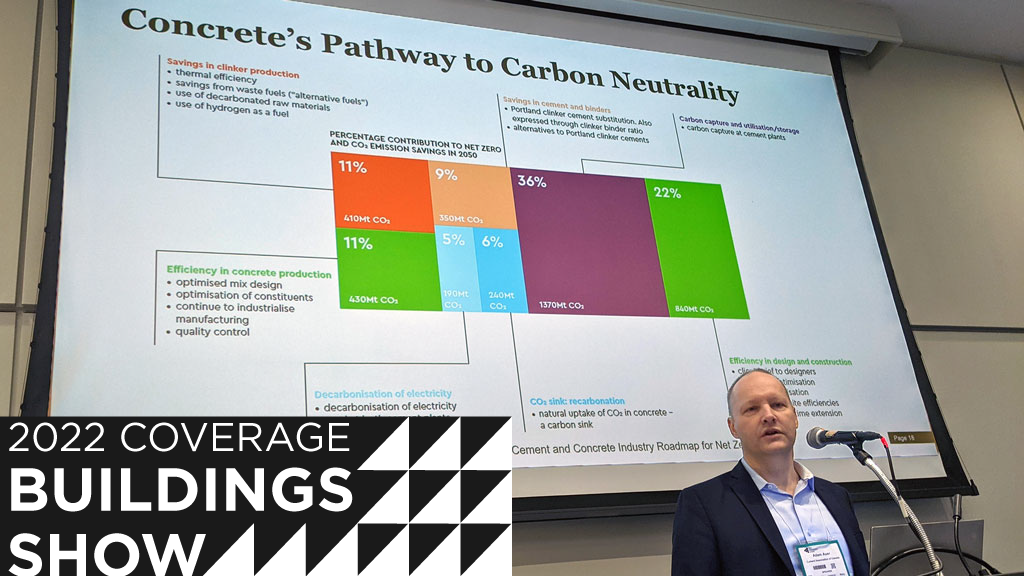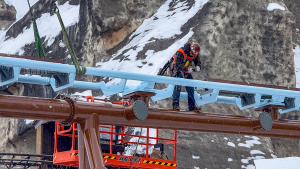Cement and concrete have a significant environmental footprint when it comes to greenhouse gas emissions, but the industry has created a roadmap and is taking steps to accelerate decarbonization in Canada.
The measures and strategies they are working on were discussed during a session at the Buildings Show entitled Canadian Cement and Concrete Industries 2030-2050 Roadmap for Net Zero Concrete.
“As an industry we’ve been working and improving our carbon footprint for many decades now but when we look at the net-zero challenge we spend a lot of time not just thinking about what that means from a manufacturing perspective, but what are the other levers that we have to reduce carbon along the value chain. Who we need to work with in order to be able to do that,” Adam Auer, president and CEO of the Cement Association of Canada, told attendees.
“We’re looking not just at the material production side but how can be more innovative in our design and construction processes so that we’re taking advantage of different base design opportunities, even changing the construction schedule can open up opportunities for decarbonization. Efficiency in design, are we using concrete — and this would apply to all materials — efficiently when we are building our infrastructure? What are some of the end-of- life solutions as well: material recovery, recycling, circular economy type approaches.”
About seven to eight per cent of global emissions comes from the manufacturing of cement used to make concrete, Auer said. On the cement side there are two sources of emissions. The first is fossil fuel emissions.
“Our kilns need to get quite hot, 1,500 degrees or so and traditionally that heat comes from fossil fuels,” said Auer. “There are alternatives that can be used to reduce that carbon footprint. The lowest hanging fruit right now tends to be waste materials, things like construction demolition waste.”
The bigger challenge for the industry is about two thirds of emissions come from the chemistry of making cement. The main ingredient in cement is limestone which contains calcium carbonate.
“When you put that in the kiln at high temperatures to create the reactions you need to make clinker, which is the active ingredient in cement, you are taking that carbon out of the limestone and that’s about 60 per cent of the emissions for manufacturing cement,” Auer explained.
“There is really only broadly speaking two or three strategies to reduce those emissions. One is you use less of that kiln fire material to make your cement, you use less cement to make your concrete, so the material efficiency type approaches, or ultimately we’re going to need to capture that carbon and either sequester it underground or find alternative pathways for using that carbon in ways that locks it out of the atmosphere.”
The industry has created a roadmap outlining the phases in the net-zero journey.
“We looked at the clinker production, fuels and carbon capture. We looked at cement, supplementary cementitious materials, blended cements etc. We looked at concrete, mix optimization. We’re looking at construction, not using more concrete than you need and finding those design opportunities to use lower carbon concretes,” he said.
Auer explained through working more collaboratively with the construction sector they can get about 20 per cent emissions reductions.
“We’ve got about a third of our emissions reductions that we think can come from low carbon fuels, electrification of fleets, mix optimization, use of additives, decarbonization of the electricity supply that’s used to power our manufacturing facilities,” he said.
One of the main barriers faced is reluctance in the industry to try innovative products or strategies.
“The codes and standards process moves like molasses so every time you want to introduce a new cement formulation or concrete formulation you’ve got at least a five- to 10-year process to get that recognized in the codes,” Auer said. “On top of that once it’s in the codes you’ve got to convince engineers to use it.
“We need to be driving more comfort with the innovations that are coming and are needed to decarbonize.”
Auer said collaboration and partnerships will also be crucial to meeting net-zero goals. The federal government in particular has put in capital supports, investment tax credits and is looking at other financing mechanisms to derisk those investments and attract private capital. Up until recently the federal government had no policies to consider carbon in its procurement decisions, he noted.
“For us this created a real challenge, because we’ve got carbon pricing and other pressures to reduce our carbon and you produce a lower carbon material and the same governments that are pushing you to reduce your carbon won’t buy that material to make sure that you are able to get those reductions you need to stay ahead of regulatory policy,” Auer said. “That’s really the exciting space for us now is that we seemed to have cracked that nut.”
Follow the author on Twitter @DCN_Angela.








Recent Comments
comments for this post are closed